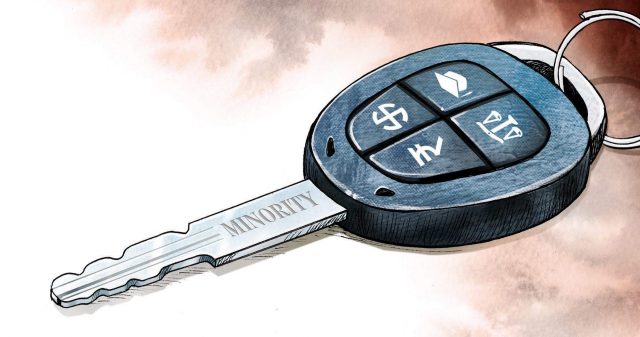
The Karnataka government’s decision to declare that the Lingayat community would be a minority religion distinct from Hinduism has brought to fore all that is rotten in our system. The move is the latest in such bids made by different sections of Hindus over the years to get a fair deal, save their institutions and religious places from interference by wily politicians; and a vice-like grip of bureaucracy—notorious for its inefficiency, red tape and corruption.With this divisive move, a beleaguered Congress in the poll-bound state hopes to beat anti-incumbency and win over a large section of Lingayats, 20 per cent of the electorate.
The final decision on the issue, however, will have to wait until after the declaration of the poll results on May 15, since the election code of conduct has come into effect. The entire exercise is in line with the strategy Congress has followed ever since it outsourced its intellectual paradigm to the Left in 1970s i.e. to unite the Muslims in the name of their faith and divide Hindus on caste basis. The moot question, however, is why sections of Hindus in India no longer want to be known as Hindus, and seek a minority tag. In Pakistan it is just the opposite. A constitutional amendment in Pakistan in 1974 had declared Ahmadis (a sect of Islam that has emerged from the Sunni tradition) as non-Muslims.
The persecuted community of Ahmadis, has since been asking to be taken back into the Islamic fold, for life is easier for Muslims in Pakistan. Being a non-Muslim condemns one to the life of a second-grade citizen in an Islamic country.“I am proud to be a Hindu,” Swami Vivekananda had declared at the historic Chicago Parliament of Religions in 1893. But officials of Ramakrishna Mission—an institution set up by Vivekananda himself to spread the teachings of his guru Sri Ramakrishna Parmahamsa—claimed through a petition in 1980s that they were not Hindus but followers of a minority religion called Ramakrishnaism.
Why did the Ramkrishna Mission take such an absurd stand? Because it felt the burden of bearing a Hindu identity. The mission wanted to gain the privileges accorded only to minorities in India, specifically, the right to manage their extensive educational institutions, free of rapacious state control. The Mission’s labyrinthine efforts to claim minority status, however, come to nought when on 2 July 1995, the Supreme Court ruled that neither Sri Ramakrishna nor Swami Vivekananda founded any independent, non-Hindu religion.
Sikhs were probably the first major community to move out of the Hindu fold. They did so in the last decade of 19th century. Behind all such dubious moves aimed at fragmenting the Indian society, the mischievous hand of the British has been obvious. ‘Secularists’ of various hues have since taken the divisive enterprise from where the vile British had left.Such is the perversity in the system that the state shamelessly takes a good part of what is offered by devotees to their Gods in Hindu temples. The cash is partly used to fund the state budgets and ironically also to finance Mosques and Churches whose agenda sometimes includes evangelisation and their targets invariably are destitute Hindus. If non-Hindus in India can manage their shrines, institutions and places of worship, why can’t Hindus be allowed to do so as per their respective traditions?
The Constitution-makers in a bid to protect minorities from majoritarian interference had inserted a series of Articles. What was meant to prevent discrimination against minorities has in fact turned out to be an enabler of discriminatory treatment by the state against the majority. It is this discriminatory treatment against the majority that the Lingayats are waiting to be relieved of by turning themselves into a minority. By declaring that they would not be classified as Hindus, the Lingayat mutts and institutions would be free from interference by the state. The Lingayat leaders or rather sections of them, while arguing for a non-Hindus status for their community, however, are not speaking of protecting their religious and social institutions while asking for this change.
Instead, they are only emphasising the various beliefs and practices which make them “different” from Hindus. Considered to be a leading Lingayat intellectual S M Jaamdar in a newspaper interview has said, “Don’t tell us we are Hindus; we are not anti-Hindus, we are different.”
That raises a serious question: Who is a Hindu? Is it one who practices or rejects caste? Or one who goes by the Vedas? One who believes in the epics and epic personalities? Or one who worships idols and visits temples? One who wears the sacred thread? Or one who follows one of these criteria or none of these?
There are hundreds of sects in Hinduism, with their separate traditions, and distinct customs. In fact 127 of them meet each other every three years, and together they celebrate Kumbh festival.
Similarly, Muslims too are divided into many sects and sub-sects (Shia, Sunni, Barelvi, Deobandi …) and Christians into various sects as well. If these divisions are carried to their logical end a la Lingayats, where will this exercise stop?
Is it the job of the state in a ‘secular country’ to define a faith or provide a section of the population with a separate or a new religious identity? Is the state qualified to do so? The Lingayat controversy has thrown up many aspects of Hinduism that are anathema for the self-styled liberals but hold together a set of polyglot people who take pride in their land and hold forth the largest number of beliefs together or no belief at all.The question is: Why should not the majority enjoy the same rights as minorities in India?
Courtesy: New Indian Express














